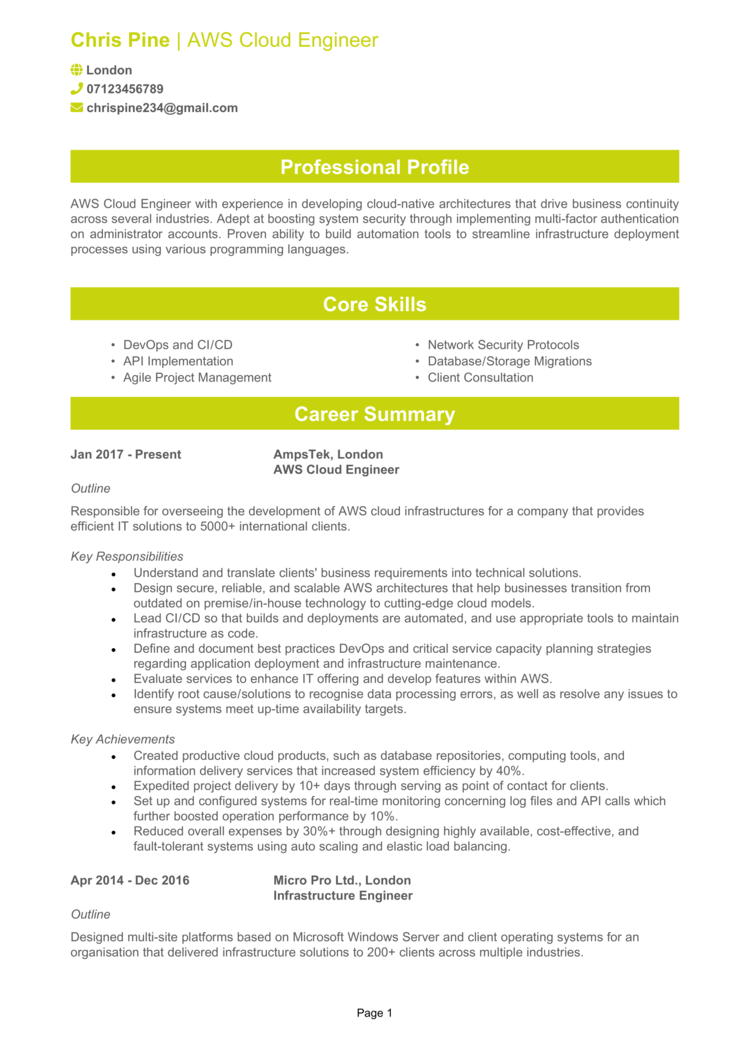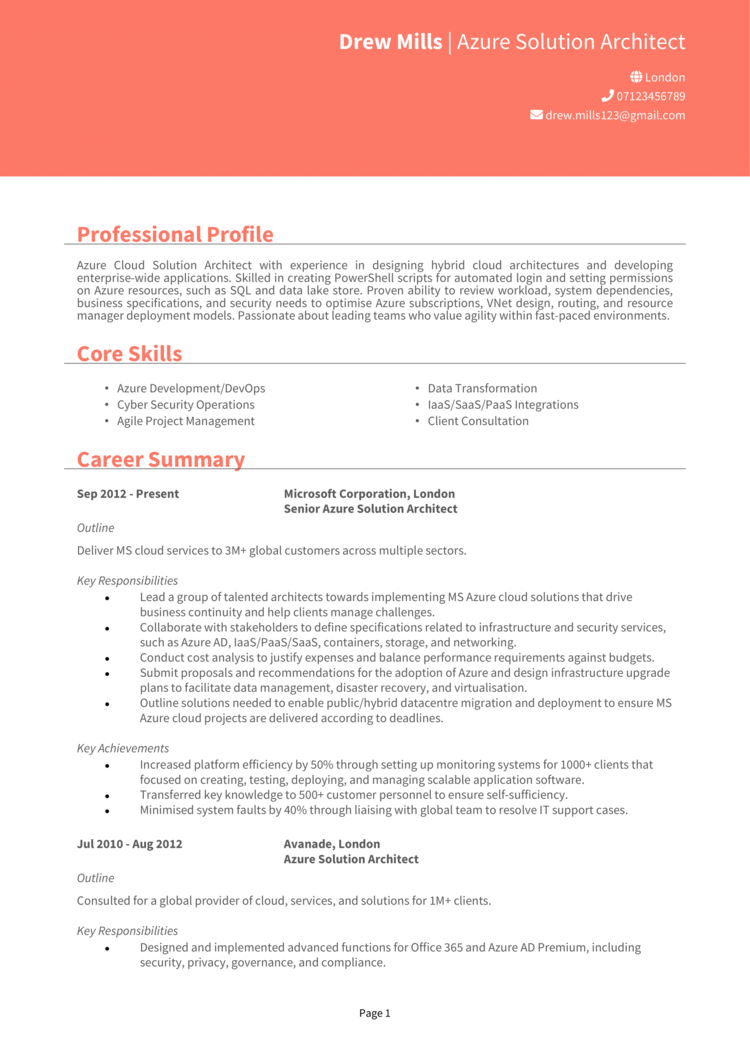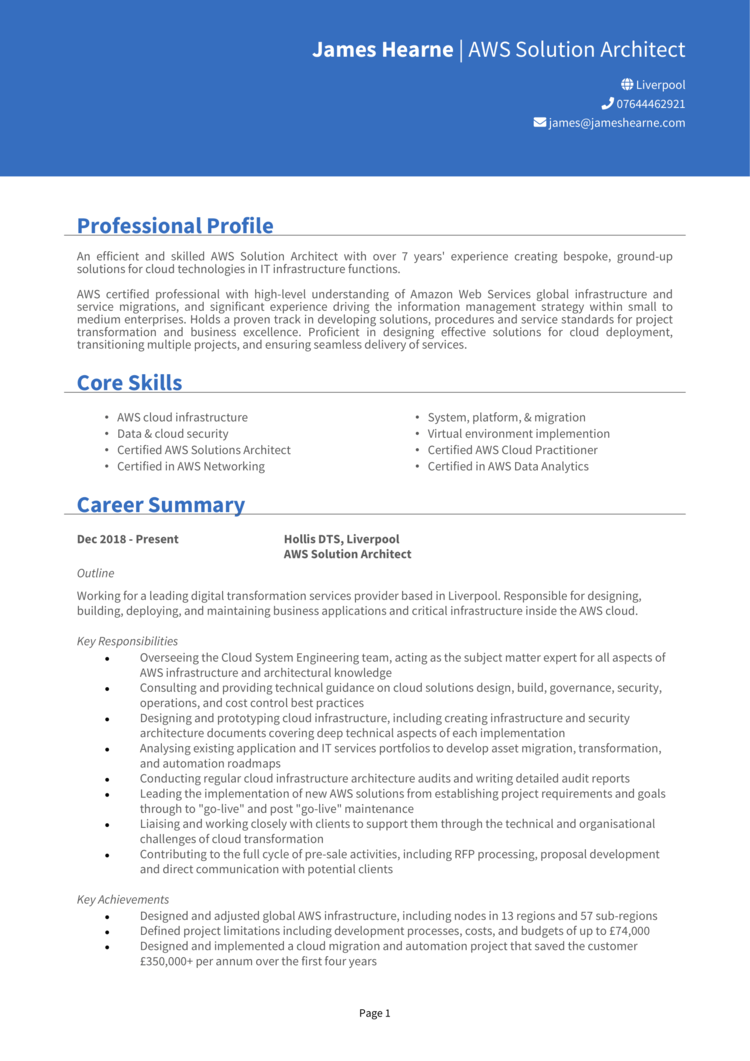You’re the bridge between business needs and technical execution – the person who can design scalable systems and explain them in a room full of non-tech stakeholders.
But even if you’ve mapped out countless systems and infrastructures, you’ll still need a CV that’s as structured and strategic as your solutions. These Solution Architect CV examples and accompanying guide will help you land the role you’re after.
Solution Architect CV

Cloud Solution Architect CV

Azure Solution Architect CV

AWS Solution Architect CV

How to write your Solution Architect CV
Discover how to craft a winning Solution Architect CV that lands interviews with this simple step-by-step guide.
Solution Architects turn complexity into clarity – and your CV should do the same. Employers aren’t just looking for someone who knows the difference between microservices and monoliths, they want someone who can take business goals and turn them into frameworks.
This guide will walk you through writing your CV full of experience and achievements that delivers real value – before you’ve even reached the interview stage.
The correct structure and formatting for a Solution Architect CV


You wouldn’t start building without a blueprint – and your CV needs the same clarity and structure. With multiple stakeholders reviewing your application, it must be easy to digest, with clear sections that highlight your strategic thinking and technical expertise.
Here’s the layout to follow:
- Name and contact details – These contact details sit at the top to provide easy access for prospective employers.
- Profile – A short summary of your background, approach, and the type of projects you specialise in.
- Core skills – Use bullet points to showcase key tools, methodologies, and architectural frameworks.
- Work experience – List past roles in reverse chronological order, focusing on business impact, team collaboration, and technical architecture.
- Education & certifications – Include relevant degrees and certifications like TOGAF or cloud architect credentials.
- Additional info – Include anything from your hobbies and interests to the languages you speak and awards you’ve earned – these are all totally optional.
To keep your CV formatting readable and professional, use a clean font, divide content into clear sections, break down information using bullet points, and keep the total length to two pages or less. You want to keep the focus on your expertise, so avoid any visual errors that’ll distract from the quality: following these simple tips will keep the hiring managers’ attention where it should be.
CV profile for a Solution Architect


Your CV profile should position you as a strategic thinker with deep technical insight – someone who knows how to deliver value across both technical and business domains. It’s your opportunity to highlight the breadth of your experience and the types of environments you thrive in.
Skip the cliches and go for tangible qualities which recruiters care about: focus less on your “passion for innovation” and more on what you’ve actually built.
Solution Architect CV profile examples
Profile 1
Experienced Solution Architect with over six years of experience designing scalable, secure, and cost-efficient IT solutions across cloud and hybrid environments. Skilled in aligning technical architecture with business objectives, managing stakeholder expectations, and overseeing implementation. Proficient in AWS, Azure, TOGAF principles, and microservices architecture. Known for bridging the gap between technical teams and senior leadership to deliver high-impact enterprise solutions.
Profile 2
Results-oriented Solution Architect with five years of experience supporting digital transformation initiatives in enterprise environments. Adept at designing end-to-end solutions across cloud platforms, integrating legacy systems, and defining architectural roadmaps. Proficient in Agile methodologies, DevOps practices, and tools such as Terraform, Kubernetes, and Azure DevOps. Strong communicator with a focus on collaboration and business alignment.
Profile 3
Strategic Solution Architect with seven years of experience delivering enterprise architecture for fintech, healthcare, and SaaS organisations. Experienced in systems integration, cloud migration, and security architecture. Skilled in stakeholder engagement, documentation, and leading cross-functional delivery teams. Passionate about designing future-proof systems that drive business performance and technology resilience.
Details to put in your Solution Architect CV profile
Here’s what to include:
- Architectural background – Summarise your experience in solution design, systems integration, or technical leadership.
- Sectors or domains – Mention the industries you’ve worked in (e.g. finance, healthcare, SaaS).
- Methodologies – Reference your approach to architecture – Agile, cloud-native, security-first, etc.
- Career focus – Note the scale or type of projects you want to work on next.
How should you write a core skills section?


This section gives employers a quick overview of your technical toolkit and strategic approach. Tailor the skills for your CV to the role, focusing on architecture frameworks, platforms, languages, tools, and methodologies that reflect your experience and strengths.
It should demonstrate both depth and breadth – covering cloud infrastructure, integration, DevOps knowledge, and cross-functional collaboration – without turning into a full inventory.
Key skills for a Solution Architect CV
- Solution Design and Architecture – Creating scalable, secure, and cost-effective technical solutions that align with business goals.
- Requirements Gathering and Analysis – Collaborating with stakeholders to understand functional and non-functional requirements.
- Technology Evaluation and Integration – Assessing and selecting appropriate technologies, platforms, and tools for solution implementation.
- Cloud Architecture – Designing cloud-native or hybrid solutions using platforms like AWS, Azure, or Google Cloud.
- System Integration – Ensuring seamless interaction between applications, databases, and infrastructure components.
- Technical Documentation – Producing detailed architecture diagrams, design documents, and technical specifications.
- Stakeholder Communication – Translating technical concepts into business-friendly language and aligning teams on project goals.
- Security and Compliance Planning – Designing solutions that meet regulatory standards and protect data integrity and privacy.
- Performance and Scalability Optimisation – Ensuring systems are efficient, responsive, and capable of handling growth and demand.
- Collaboration with Development Teams – Guiding developers, DevOps, and QA teams throughout the implementation lifecycle.
Writing about your work experience


This is where you move beyond buzzwords and show how you’ve turned business goals into functioning, future-proof solutions. Focus on how you translated complex requirements into scalable systems and made tangible improvements to performance or reliability.
Start with your most recent work experience and work backward. Don’t just name-drop tools – explain how you used them and what impact you had. Employers are looking for architects who can deliver, not just theorise.
Formatting your job history for your CV

- Outline – Briefly describe the company, the tech environment, and your role in the architecture team.
- Responsibilities – Share your core tasks using action words like “designed,” “integrated,” or “advised.”
- Achievements – Mention measurable impact – “reduced infrastructure costs by 25%,””improved system uptime,” etc.
Work experience samples for Solution Architect
Solution Architect | Veldron Systems Ltd
Outline
Designed and delivered enterprise-level cloud solutions for a digital infrastructure consultancy, supporting clients through transformation and migration projects.
Responsibilities
- Developed scalable architecture designs based on business and functional requirements.
- Led workshops with stakeholders to capture current-state architecture and define future-state goals.
- Created solution documentation, diagrams, and data flow models for cross-team reference.
- Collaborated with developers and DevOps engineers to ensure alignment during implementation.
- Assessed architectural risks and compliance with industry and security standards.
Achievements
- Successfully led the migration of a legacy system to AWS, reducing infrastructure costs by 35%.
- Improved application availability by designing a multi-region failover architecture.
- Delivered an architecture roadmap adopted by the client for long-term strategic planning.
Solution Architect | HorizonTech Group
Outline
Oversaw the design and integration of digital platforms for an enterprise technology firm, working across multiple industries including finance and retail.
Responsibilities
- Created high-level and detailed architecture designs using TOGAF and ArchiMate modelling.
- Worked with product teams to define MVP scopes and technical feasibility.
- Led architecture governance sessions to review proposed changes and system impacts.
- Integrated third-party APIs and legacy applications with new cloud-based platforms.
- Provided architecture oversight throughout project lifecycles, ensuring adherence to standards.
Achievements
- Enabled 50% faster time-to-market by streamlining the design-to-development handoff process.
- Standardised reusable architecture components, improving scalability across product teams.
- Received internal award for outstanding contribution to cross-platform integration.
Solution Architect | Novanta Digital Solutions
Outline
Defined technical solutions for a global SaaS provider, supporting the rollout of new products and improving system interoperability.
Responsibilities
- Designed cloud-native architectures using Azure services, ensuring scalability and fault tolerance.
- Worked closely with business analysts to translate user needs into architectural components.
- Performed gap analysis on existing infrastructure and developed modernisation strategies.
- Defined integration patterns for APIs, databases, and microservices.
- Contributed to enterprise architecture reviews and presented technical proposals to C-level stakeholders.
Achievements
- Improved system resilience by implementing event-driven architecture using Azure Event Grid.
- Reduced latency by 40% through service decoupling and performance optimisation.
- Led solution design for a global product launch, serving over 100,000 users within the first quarter.
How to write your education section


Certifications carry weight in architecture roles, so list your education and any credentials clearly and in reverse chronological order, starting with the most recent and relevant.
Include degrees in computer science or engineering, as well as industry certifications. If you’ve completed recent training to stay current, include that as well. As important as this all is, make sure you keep this section brief, to focus on your more important experience.
Recommended qualifications for Solution Architects
- AWS Certified Solutions Architect – Professional – Industry-standard for cloud-focused architecture roles.
- TOGAF Certification – Widely recognised for enterprise-level architecture frameworks.
- Microsoft Certified: Azure Solutions Architect Expert – Ideal for Azure-based environments.
- Bachelor’s Degree in Computer Science or Software Engineering – A solid academic foundation for the role.
- Certified Kubernetes Administrator (CKA) – Helpful for container orchestration and modern infrastructure work.





